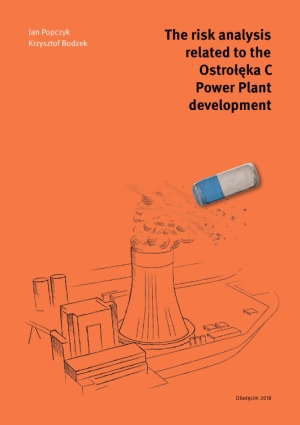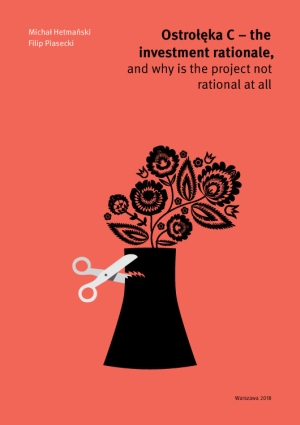The decision concerning reactivation of the Ostrołęka C power plant project was assessed negatively by numerous experts within the power industry. Below we discuss tree reports analysing financial and regulatory environment of this investment. They clearly show that the project of building the ostrołęka C, 1'000 MW, is not profitable or reasonable in the context of the electric power system in Poland.
Capacity market and the failed rescue. Updated report: Ostrołęka C - next steps for Europe’s last coal power plant
Michał Hetmański, InstrAt Foundation
December 28, 2018
Key conclusions:
- Ostrołęka C investment project would bring investors a negative net present value (NPV) of ca. -6.2 bn PLN (-1.5 bn EUR), compared to -2,3 bn PLN as the previous report showed. This exceeds the investment budget of ca. 6 bn PLN (1.4 bn EUR);
- Ostrołęka C has won a 15-year long capacity agreement worth ca. 170 mln PLN yearly or 2.7 bn PLN totally - nevertheless, the study shows that over its whole lifecycle this power plant still would not be profitable and hence inviable;
- Even if the fuel fell from sky i.e. coal was free-of-charge, just as wind and solar are, this unit would still be unviable. What is striking, the fewer hours it works, the lower the financial loss will be incurred.
- The price (LCOE) of electricity generated from Ostrołęka C will be higher than the one from renewable energy sources (RES). It might generate power at a price of 500-513 PLN/MWh, whereas studies show that onshore and offshore wind parks cost as much as 300 and 420 PLN/MWh, and photovoltaics around 440 PLN/MWh.
- Despite numerous and serious doubts about economic viability of this coal power plant, the investors and the Ministry of Energy still push for construction and avoid answering questions asked by experts and NGOs. It has still not been decided whether Enea will act as a co-investor, since it has been sued by its own labour union and its shareholder.
SUMMARY DOWNLOAD (pdf)
Ostrołęka C - next steps for Europe’s last coal power plant
Michał Hetmański, InstrAt Foundation
August 30, 2018
Major conclusions:
- In our business valuation model, Ostrołęka C will never reach positive net present value. We conclude our calculation with NPV of PLN 2.3 bn (EUR 0.55 bn) and indicate it should be classified as a value desctructing project for shareholders and hence be rejected. This investment does not generate any positive NPV even under extremely unrealistic assumption of 24/7/356 exploitation.
- The capacity market will not significantly improve the financial condition of the new coal fired power plants. In the best scenario, Ostrołęka C can get only 15% of its revenues from the capacity market.
- Even under a very optimistic scenario of a very slow increase in the CO2 emission allowances prices and a rapid growth in electricity prices – the power plant still turns out to be unviable.
- Due to administrative oversights of the investor, it is likely to happen that SPV will have to undergo environmental proceedings once again, which may significantly hamper and delay the whole investment process. This would force Ostrołęka C to meet more restrictive environmental standards (BAT conclusions for LCP). In order to avoid this, the investor “categorically excludes” the commencement of the environmental procedure by the constructing consortium (GE Power & Alstom Power Systems).
- Levelized cost of electricity (LCOE) of Ostrołęka C will be higher than of renewable energy sources. Under base scenario, it could generate power at a price of 488 PLN/MWh – or even 505 in the worst-case scenario of a rapid CO2 emission allowances increase. This is much more than in the case of any wind farms: onshore (300 PLN/MWh), offshore (420) or even PV (440).
REPORT DOWNLOAD (pdf)
SUMMARY DOWNLOAD (pdf)
Ostrołęka C – the investment rationale, and why is the project not rational at all
Michał Hetmański and Filip Piasecki, InstrAt Foundation
April 10, 2018
Major conclusions:
- The actual costs of construction of Ostrołęka C are significantly underestimated and the history of construction of other blocs of 800+ MW of capacity shows that this is a high-risk investment. It is the strong integration of the power sector in Poland that is the reason of the unreal estimation and presumptions within the businessplan.
- The power market for Ostrołęka C is not a certain source of funding. British experience shows that power mechanisms are the most profitable for existing units which support new and large investments. On one hand, this is a potential source of revenues, but also a threat - considering contractual penalties.
- The analyses have shown that the difference between actual and estimated costs of exhaust fumes treatment installation exceeds half a billion PLN. Because of the investor's administrative negligence, the integrated permit for the investment expired and the whole process must be repeated, considering the strict BAT guidelines. This increases the investment costs, which are very high anyway. It may also delay the launch of the bloc.
SUMMARY DOWNLOAD
The risk analysis related to the Ostrołęka C Power Plant development
Jan Popczyk, Krzysztof Bodzek, Silesian University of Technology
April 10, 2018
Major conclusions:
- The planned investment in Ostrołęka C power plant hampers or even blocks potential investment in renewable sources of energy and related services in Ostrołęka region.
- Alternative investments in distributed renewable sources would contribute to new employment more than 45% higher than in the case of the total employment at operating the new bloc and coal mining for its purposes. If the coal is imported - employment related to renewable energy generation would be 1,200% higher.
- Prices of power generated at Ostrołęka C power plant will be higher than prices of power from renewable sources. With the time passing, this proportion will change to the advantage of renewable sources with development of this sector (falling prices) and rising costs of CO2 emissions allowances (allowance cost).
SUMMARY DOWNLOAD




